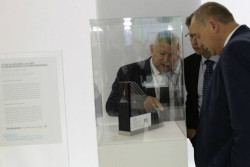EU research opens window on energy saving building innovations
These innovations have been achieved through the EU-funded MEM4WIN (Ultra thin glass membranes for advanced, adjustable and affordable quadruple glazing windows for zero-energy buildings) project, which has made significant headway in developing novel smart window technology to help architects design zero net energy buildings. These buildings produce as much in renewable energy as the energy they consume. ‘Windows that can control and harvest energy will have a big industrial impact so long as they are affordable,’ says project coordinator Andreas Mader MEM4WIN project coordinator from Lisec, Austria. ‘The innovations being developed by this project can be used for residential and office buildings in every climate zone and for new constructions as well as the retrofitting of older buildings.’ The project, launched in October 2012, has developed a novel insulated glass unit for frameless quadruple glazing, which contains ultra-thin glass membranes that can be directly applied to façades. ‘Due to the use of ultra-thin glass membranes (less than 0.9 mm) in this new frameless window design, the weight is reduced by 50 %,’ explains Mader. ‘We have received a lot of commercial interest in our project, and the quadruple glazing has great potential. We will present the product at the Frontale 2016 exhibition in Nürnberg, Germany.’ Low-cost ink-jet printed organic photovoltaics (OPV) and integrated solar thermal collectors have also been developed, enabling energy harvesting for power generation and hot water. Replacing expensive materials like indium titanium oxide and silver with graphene and exploiting cost-effective processing such as inkjet printing is expected to lower fabrication costs by about 20 %. ‘The next step is to print these OPV modules with an industrial inkjet printer, a technique that offers perfect design freedom along with the ability to print very large areas,’ says Mader. ‘For example, OPV modules were used for the German pavilion at the World Expo 2015 in Milan, where ‘trees’ integrated with OPV modules provided shade for visitors while at the same time generated solar energy.’ Movable micro-mirror arrays to optimise energy efficiency have also been developed. ‘These have some very clear advantages,’ says Mader. ‘They are protected between the window panes against wind, weather and dirt, and the miniaturisation will considerably improve the mechanical stability of such devices. They have also been designed to be maintenance free for their whole lifetime.’ Another innovation has been the development of a reliable process for preparing defect-free transparent graphene. The new transfer process enabled the project team to apply the graphene – a carbon sheet just one atom thick that offers impressive strength, flexibility and electrical conductivity – onto glass at the lab scale. ‘Three layers of graphene were deposited, and we were able to demonstrate that with graphene, we can make functional solar cells with good optical density,’ says Mader. Upscaling the technique is currently under investigation. The MEM4WIN project is due for final completion in March 2016, after which time the project partners will investigate opportunities to commercialise the technology. ‘These innovations will help slow global climate change and meet Europe’s energy challenges,’ says Mader. ‘Importantly, in difficult economic times, the project will also strengthen Europe’s position in a market poised for tremendous expansion.’ Source: Based on an interview with the project coordinator
Keywords
MEM4WIN, energy efficiency, smart windows, ink-jet, zero energy, buildings, renewable energy, solar thermal collectors, graphene



